A Lineman's ViewPoint
by Carol McDougald
Reprinted from "Crown Jewels of the Wire", July 1988, page 15
"Insulators are my life." says Texas collector,
A.L. Rash
With this being the month of the National Show in Houston, it is fitting that
we spend some time with one of Texas's earliest collectors, Mr. A. L. Rash of
Lumberton, Texas. It was several years ago that Dee Willett of Bakersfield,
California, first contacted me regarding the fine collection of insulators
possessed by his friend, A.L. Rash. "Mr. Rash has a collection that has the
most one, two and three of a kind insulators that I have ever seen," was
the comment from Dee Willett. Following the regional show in Houston last
summer, John and I spend 24 hours with Arnold and Joyce Rash. We had a wonderful
time photographing the fine collection of insulators and enjoyed their southern
hospitality.
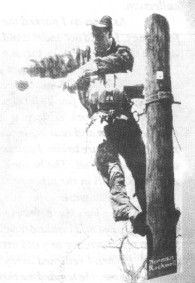
"Insulators are my life," was the comment that A.L. Rash
made time and time again during our visit. His statement was clearly evident as
he picked up a favorite insulator and gently caressed it.... he does love his
collection.
Rash has worked around insulators all his life. He began at 16
working as an electrical assistant with the Civilian Conservation Corps camps,
the youth version of the Depression-era Works Project Administration established
by Franklin D. Roosevelt. After serving with the Army infantry in World War II,
he became a line foreman and eventually retired after 32 year with Southwestern
Bell Telephone Company.
He became interested in collecting insulators almost 20
years ago when the utilities began to phase out telephone and telegraph wires in
favor of the underground cables. His collection is intended to preserve a part of
American history that he feels should be remembered.
The preservation of history
has certainly been one of A. L.'s main objectives. The AMERICAN COLLECTOR
magazine featured the column, "The Lineman's Viewpoint" in which A.L.
liked to "put a little comedy in my stories" to enhance the
information he shared on insulators. I share the following with you from the
February, 1981, issue:
"During one of my visits to Uvalde, Texas, so close
to Mexico, I decided to go south of the border to track down some old telephone
insulators for my collection.
As soon as I parked the car, a fellow approached with his hand out
for money. I could not understand a word he was saying, but I correctly guessed
that he was offering to act as my guide.
Likewise, he could not understand me
when I tried to explain that I was searching for old insulators. After a long
period of struggling with the language barrier, I finally hit upon what I
thought was a real bright idea. I just knew it would work. I drew a picture of a
big farm, complete with a bull, telephone lines and real big insulators. I was
sure he would understand. As I handed the picture to him, I pointed to the big
insulators and he nodded his head as if he understood. The he took off up the
street with my picture in one hand and my $20 bill in the other.
While waiting
for his return, I visited the telegraph office and explained to a lady there
what I was looking for. She quickly informed me all telephone lines and
insulators belonged to the government and it would not be wise to try to remove
any old insulators.
When I returned to my car, there was my would-be guide
patiently waiting for me. He handed me three tickets to a bullfight. I guess the
only thing he recognized in my drawing was the BULL!"
You can see why his column was one of the most popular in the magazine.
"When I take my display out, it's to educate people. That's the only reason
I do it." He has displayed at the Spindletop Museum, Big Thicket Museum and
the Edison Plaza Museum (see the June, 1988, issue) at the Gulf States Utilities
building in Beaumont, Texas. Local television cameras have also been to his
home to photograph his collection. He offers to show his collection by
appointment.
Although there are far too many fine insulators to print in a single
issue of this magazine, we share the following:
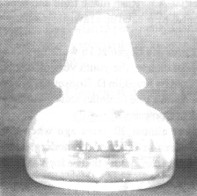
CD 180 LIQUID INSULATOR |
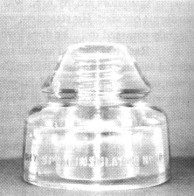
CD 182
DRY SPOT |
One of the most interesting pieces in Rash's collection of threadless
insulators was the CD 731 in white milk glass. It is shown on the left next to a
white milkglass CD 164 Maydwell-20. The wire groove is a "V-shaped"
style and the piece was found in Troy, New York by a telephone man.
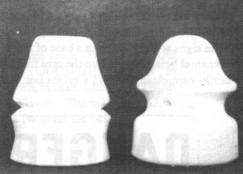
White milkglass threadless and Maydwell-20 |
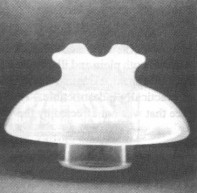
Opalescent Fry Glass cable
Insulator |
One of the Interesting go-withs that A.L. has in his collection Is a brass
box which has the Macomb Insulator logo embossed in the lid. It was probably a
paperclip or stamp box for an employee's desk. (Below)

(Below) Arnold L. and Joyce Rash. "If I had my life to live over, I'd
work for the same company, I'd marry the same woman, have the same adopted kids,
natural kids and grandkids and I wouldn't make one change."
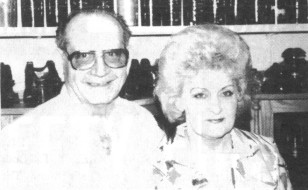
| 